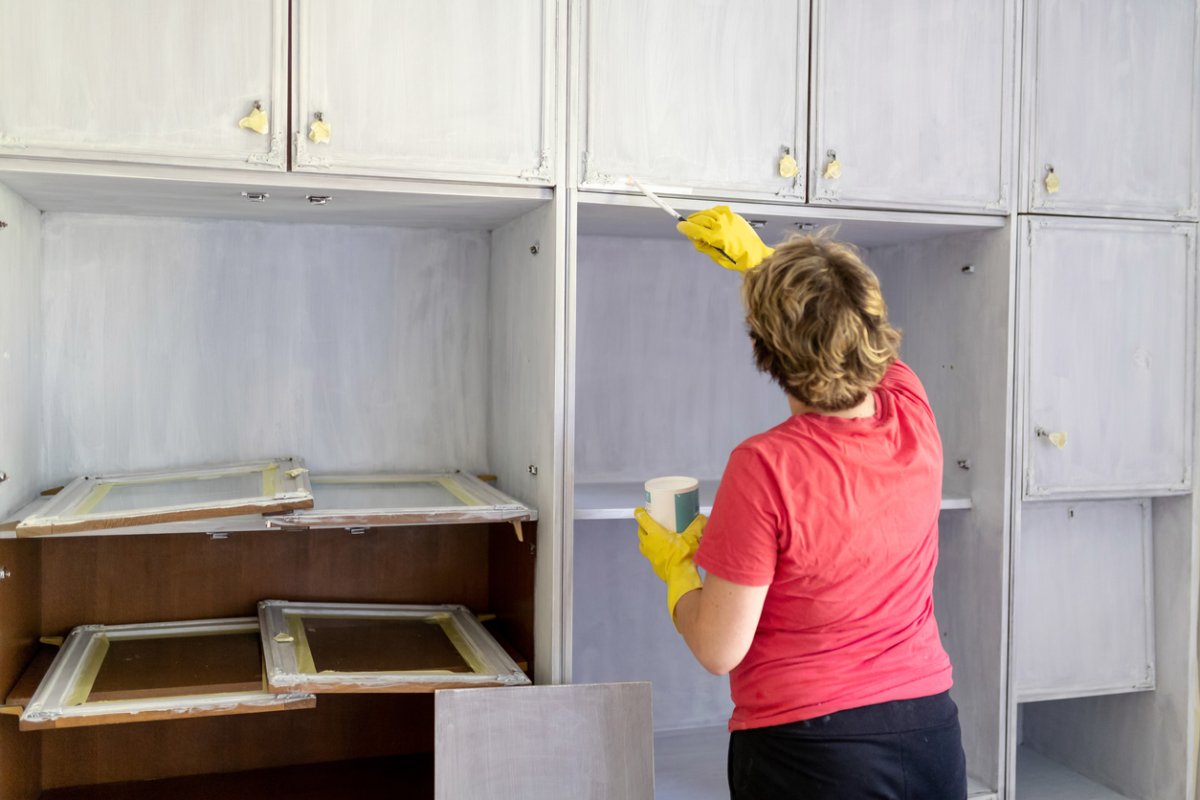

We may earn revenue from the products available on this page and participate in affiliate programs. Learn More ›
Q: My wife and I live in an older, rustic home, and we’d like to freshen it up with some paint. What’s the best paint for wood surfaces in our home, indoors and out? Is oil-based or water-based the better choice? Which paint finish should we choose?
A: Wood is adaptable enough to receive either water- or oil-based paint, as long as you coat it with primer beforehand. But the myriad types of paint and sheen within these two categories can present you with a dizzying array of options at the paint store. Ultimately, the best type of paint and sheen to use depends on the wooden surface you’re painting. Ahead, learn which of the most common types of paints and sheens on the market are best suited for your wood painting project.
There are many types of paint and paint sheens for wood.
Water-based paint is sold at paint stores and home centers in traditional latex ($15 to $40 per gallon), milk ($15 to $25 per quart), or chalk varieties ($15 to $35 per quart), while oil-based paints are either alkyd-based (made with synthetic resins called alkyds; $20 to $50 per gallon) or plant-oil-based (made with linseed or other plant oils; $30 to $50 per quart). Traditional latex, alkyd-based, and plant-oil-based paint also come in a number of sheens: flat (matte), eggshell, satin, semi-gloss, and high gloss, in order of lowest to highest luster. You can expect to pay one to two dollars more per gallon for every step up on the sheen spectrum. Milk and chalk paint, which you can buy or DIY with good results, are naturally matte, so commercial cans of these paints don’t usually indicate a sheen.
Paint a coat of stain-blocking primer on the wood, no matter the project.
Whether you’re painting unfinished or painted wood, it’s essential to prime it before painting. Otherwise, tinted organic compounds in wood called tannins will bleed into any water-based paint applied on top—especially when painting over dark, tannin-rich woods like knotty pine. Primer creates a barrier between wood and paint that prevents this tannin bleed-through. While oil-based paint is less susceptible to tannin bleed-through, primer (which runs $16 to $25 per gallon) is still recommended under all paints to ensure an even foundation that will help you achieve a more uniform paint finish. Choose a primer that matches the type of paint you’re using: stain-blocking latex primer for latex paint and stain-blocking oil-based primer for oil-based paint. How knotty your wood is may guide you in deciding which types of primer and paint you use, as oil-based primers (like paints) do a better job penetrating and sealing the wood and block tannins more effectively than water-based primers.
RELATED: The 8 Best Paint Primers for Indoor, Outdoor, and General Use
In most cases, the best paint for wood furniture is alkyd-based oil paint.
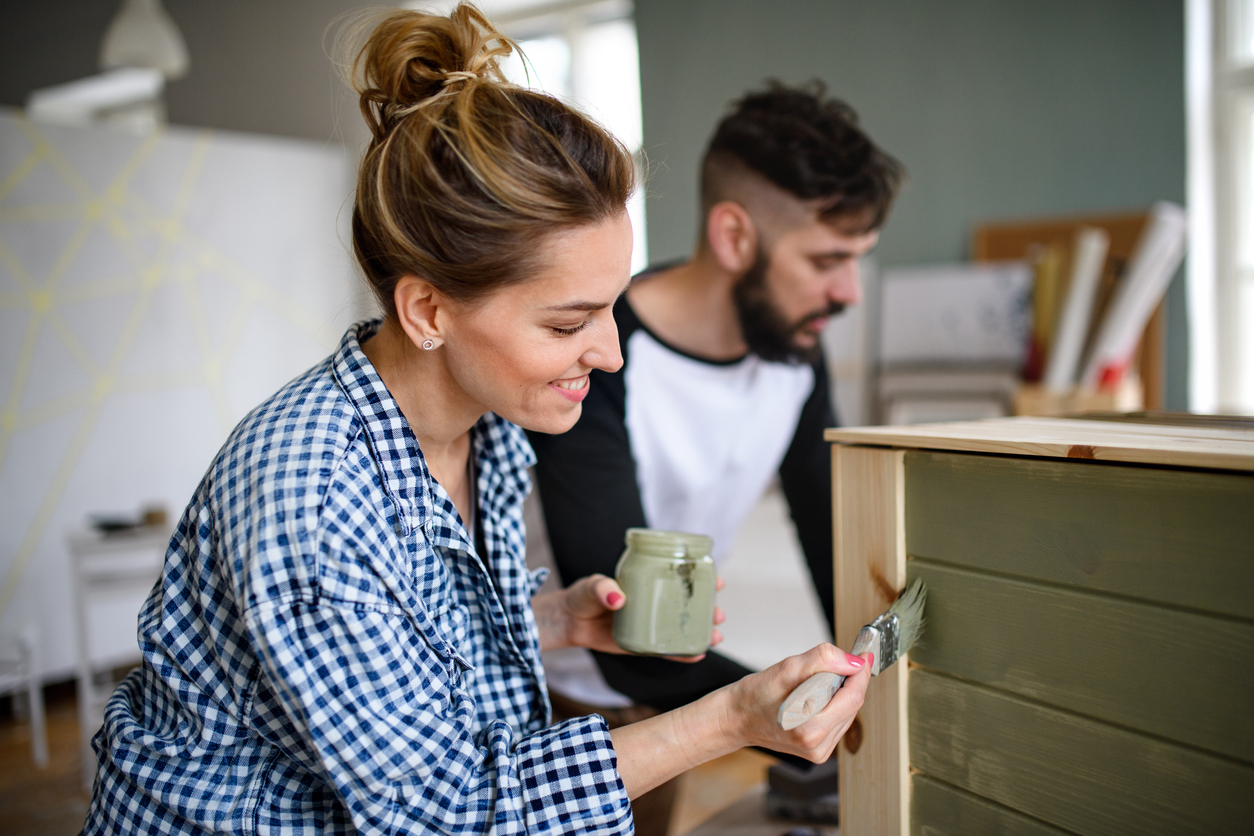
Alkyd-based oil paint dries into a rigid layer over wood and continues to harden on the wood surface over time, making wooden chairs, dining tables, and other frequently used furnishings less susceptible to scuff marks or dents than they would be if covered with a more flexible coat of water-based paint. This type of paint dries faster than plant-oil-based paint (some plant-oil-based paints take up to 3 days to dry), so with an alkyd-based paint, your furniture will be dry and back in use much sooner. Opt for a semi-gloss or high-gloss sheen; these are the smoothest to the touch and the easiest to wipe clean. These sheens also hold up better to harsh cleaners and scrubbers, which may tarnish a lower-luster paint coat.
On decorative furnishings, use traditional latex paint.
Water-based latex paint is a top choice for furnishings that are more decorative than useful, like entryway tables or stair spindles, since it can be tinted to match any color you desire for the furniture and dries faster than oil-based paint. (For reference, latex paint coats normally dry to the touch in 1 to 4 hours as opposed to 8 hours or more for oil-based paint.) Latex paints today are also cheaper, lower in volatile organic compounds (VOCs), and less likely to show pesky brush marks seen on alkyd-based oil paint coats. Latex paints with a flat to satin sheen reflect less light than glossier sheens, so a smooth coat can mask furniture flaws (nicks and scratches to be painted over) more effectively. They’re also the most inexpensive sheen options for furniture you don’t handle often.
RELATED: Solved! The Best Paint for Furniture
Use milk or chalk paint on furniture that’s distressed.
Water-based milk paints and chalk paints are known for their elegant shabby-chic look and matte sheen, making them an attractive option for furnishings that would benefit from a distressed look. Milk paint cracks, flakes, and distresses easily, which gives it a more pronounced weathered character that’s ideal for focal point pieces like wooden hutches or headboards. Chalk paint less easily distresses on its own, giving you more control over the distressed effect and usually resulting in a softer, more subdued aged appearance that’s perfect for items that complete a room, such as end tables or wooden coat racks.
The best paint for wood cabinets in the kitchen and bathroom is alkyd-based oil paint.
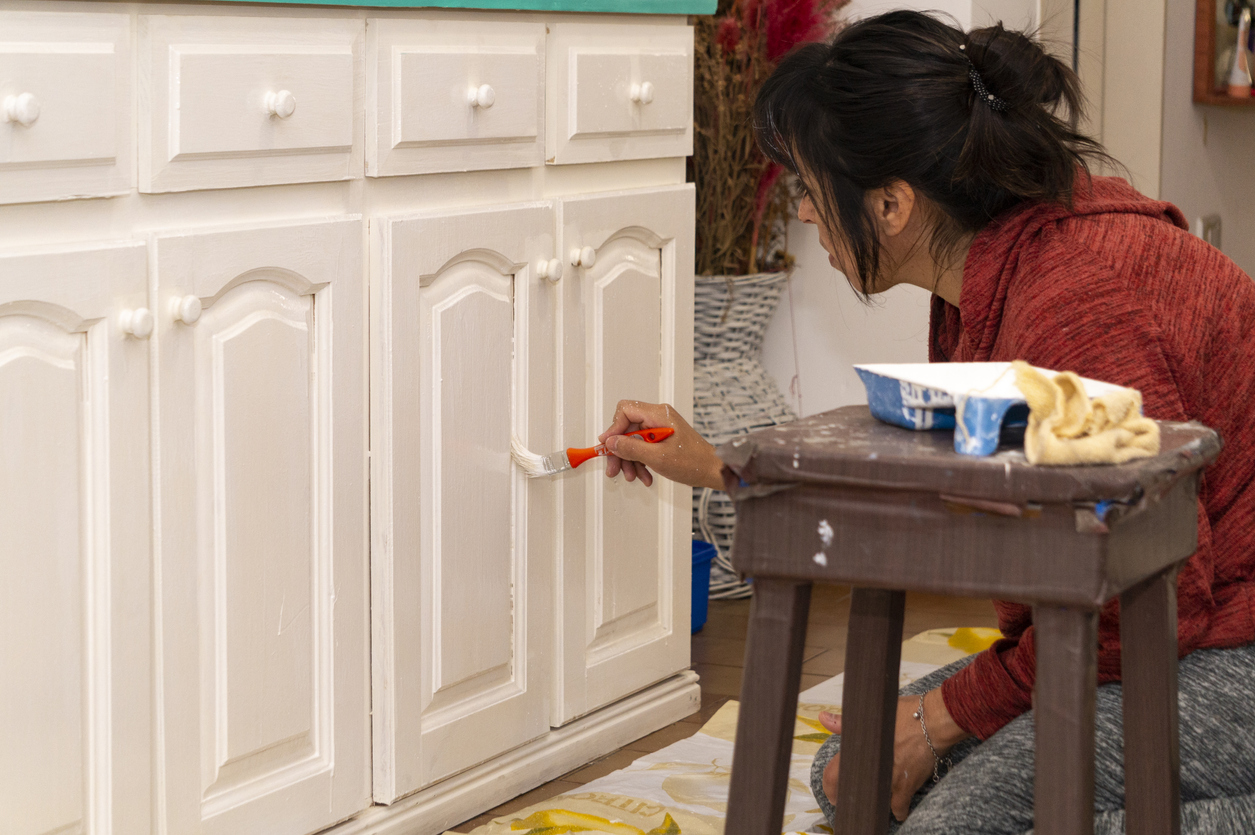
Cabinets, particularly those in the kitchen, are exposed to moisture from water, cooking liquids, and cooking fumes. These are absorbed over time to a greater degree by the average water-based paint, and this can spur the growth of mildew or mold on the cabinet surface. Oil-based paint is water- and rot-repellent. The best paint for kitchen cabinets is an alkyd-based paint rather than a plant-oil-based paint; a downside of using plant oil-based paint on moisture-exposed cabinets is that it’s less likely to turn yellow over time. Semi-gloss or high-gloss paint sheens are your best bets; their nonporous, smoother finish is easier to clean, and moisture beads on these surfaces rather than being absorbed, so the paint coat doesn’t weather or fade with time. The exception is shelves in the cabinet interior; if you paint these shelves, you want a flat to satin sheen, which will be better at withstanding the weight of dishes.
RELATED: How To: Paint Kitchen Cabinets
Latex paint is your best bet for cabinets in dry areas of the home.
Latex paint is the most inexpensive and fastest-drying option for cabinets in spaces where moisture isn’t a concern—say, in a home office or media room. A flat to satin sheen is best for cabinet shelves, especially those that carry electronics or other heavy objects, but choose a semi-gloss to high-gloss sheen for the cabinet exterior to make lighter work of cleaning it.
Alkyd-based oil paint is the best paint for wood trim.
Interior molding—whether baseboards, door casings, or window or ceiling trim—accumulates a fair amount of scuff marks, dents, and dings over time. The rigid quality of an oil-based paint coat defends against these flaws more effectively than a softer and less durable water-based paint coat. Trim being a noticeable feature in the home interior (particularly when set against white walls), you’ll want to choose an alkyd paint over a plant-oil-based paint to avoid the risk of yellowing. As with cabinets, choosing paint in a semi-gloss or high-gloss sheen makes the job of cleaning dingy trim easier.
RELATED: The Best Interior Paints for Every Room of the House, Tested and Approved
For ornate trim like crown molding, latex paint might be a better option.
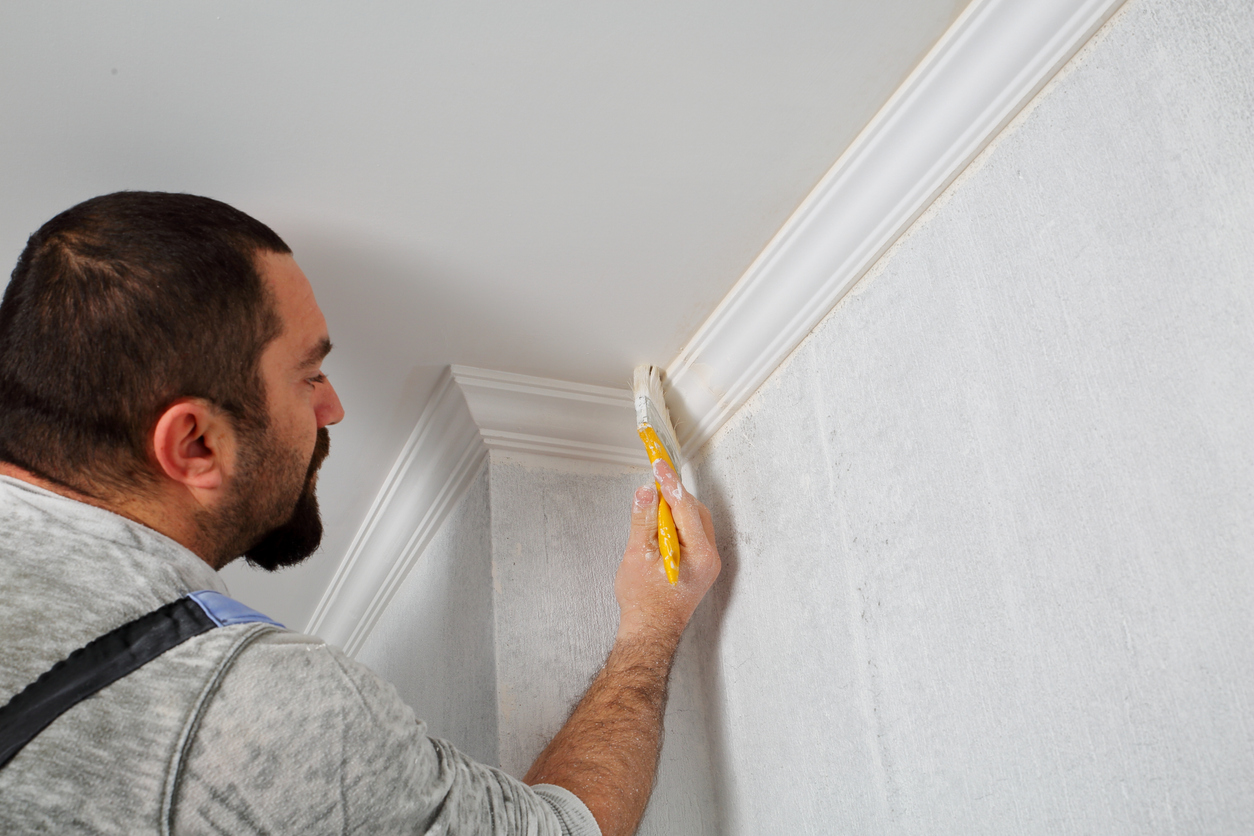
Decorative trim—for example, a crown molding with scrollwork—often has grooves that oil-based paint has trouble reaching into and coating since it’s thicker and more viscous than water-based paint. The lower viscosity of water-based paint makes for a thinner paint that more readily reaches grooves and recesses in trim, getting you more uniform paint coverage. A flat to satin sheen is the most inexpensive option for ornate trim in low-traffic areas you don’t need to clean often.
The best paint for wood floors is alkyd-based oil paint.
It can handle daily abuse from boot heels, sopping shoes and umbrellas, and furniture relocations without becoming water-damaged or dented. (The softer, more flexible surface of a water-based paint coat doesn’t hold up as well on painted wood floors in high-traffic zones.) While plant-oil-based paint also offers these benefits, it’s too cost prohibitive for most homeowners to apply to the large surface area of a floor. Choose a semi-gloss or high-gloss paint finish; coarser flat to satin sheen finishes are more labor-intensive to mop up.
RELATED: How To: Paint a Wood Floor
Pick plant oil-based paint for small knickknacks.
Alkyd-based oil paints are more affordable and readily available, but plant oil-based paint is still popular for enhancing the natural patina of small wooden objects: think wooden jewelry boxes, photo frames, and decorative items, where its steeper price isn’t cost-prohibitive. Since plant oil-based paint dries into a slightly softer and more supple surface than alkyd-based oil paint, the wood surface can expand and contract with temperature changes with little risk of the paint coat turning brittle and cracking. Moreover, since the paints usually comprise only plant oil, oil drying agents, and natural pigments, they emit few to no VOCs. A semi-gloss to high-gloss sheen reflects more light, so it will make small objects stand out better than a lower luster sheen would.
Acrylic is the best paint for wood crafts.
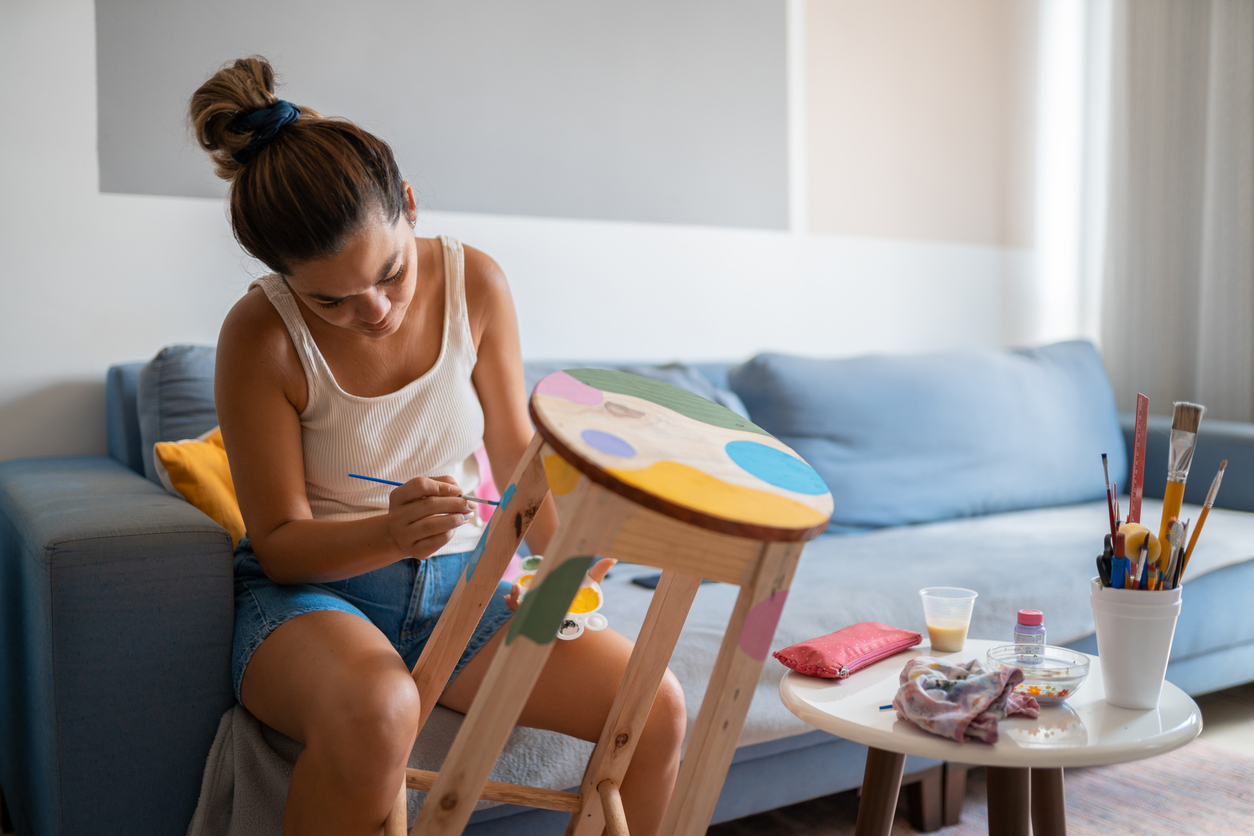
Like latex paint, acrylic is water-based, so it’s generally easy to clean up and emits fewer VOCs, making it ideal for crafty endeavors. Acrylic craft paint for wood is reasonably priced and available in finishes from matte to glossy. A range of vibrant colors as well as metallic and glitter varieties accommodate all kinds of crafts, and the paint can be easily thinned with water. Acrylics are durable and dry quickly, which is great if you’re planning on adding a second coat but less great if it dries while you’re still working on the first.
For outdoor furniture, use exterior latex paint.
Alkyd-based oil paints used to be the go-to option for exterior surfaces, but today’s latex paint is more durable than ever and offers advantages like faster drying time, easier cleanup, and better coverage. For all of these reasons, the best outdoor paint for wood furniture is a good-quality exterior latex. But for quick, durable, and smooth coverage for pieces that don’t have a lot of flat surfaces—think chairs with spindles or wicker furniture—an exterior (or interior/exterior) spray paint may be the way to go.
